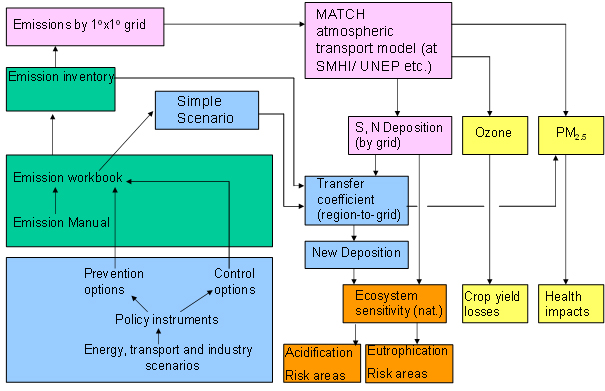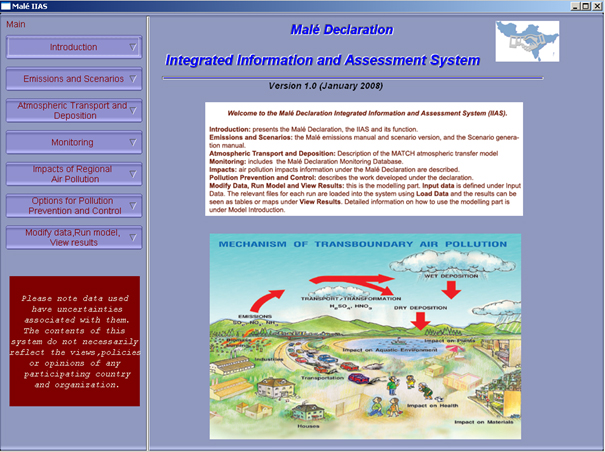Modelling Activities
Malé Declaration achievements and results
Modelling activities under the Malé Declaration have demonstrated the transboundary dimension of the air pollution problem in South Asian conditions; • The potential for monitoring and modelling results to be used together to build up a regional picture of the air pollution situation in South Asia has been clearly demonstrated. • A regional centre on modelling activities is being established in Iran.
Integrated Assessment Modelling
Malé Declaration achievements and results
An Integrated Information and Assessment System (IIAS) has been developed by the Malé Declaration that can take emissions and monitoring data from South Asia and assess health impacts from PM, crop yield impacts due to ozone and ecosystem impacts of nitrogen and sulphur. The Malé Declaration now has the capacity to quantify the benefits, in terms of reduced impacts, of different scenarios of emission abatement.
Capacity building for integrated assessment modelling activities The different pieces of the knowledge jigsaw required by policy makers in the Malé Declaration region are put together in the Malé Integrated Information and Assessment System (IIAS) which has been developed through collaboration between UNEP, SEI and SMHI. In Phase II consultation on the form of the system was undertaken with the NIAs of the Malé Declaration to ensure that the system would be useful to the end users. In Phase III the system was put together linking the different inputs to develop results that can inform decision making. The IIAS has also been designed to have the flexibility to allow countries to alter inputs and assess the changes to different impacts. Much of the work has gone into developing the input data for the IIAS, especially MATCH atmospheric transport model results, and linking these to impact-relevant data, such as dose-response relationships. Pollutant emissions are processed by the atmospheric transfer model to give depositions and concentrations. Figure 1 shows the elements of the calculations that can be made within the Malé Declaration IIAS. At the moment the emission data are from the EDGAR global emission database, but these are being replaced by the emission estimates from the countries as they are derived. The system allows simple scenarios to be developed (increase or decrease in emissions by a certain percentage). These can be used to create new deposition estimates using the region to grid transfer coefficients developed by running the MATCH model for estimates of sulphur, nitrogen and particulate matter emission. Transfer coefficients cannot be used for ozone and so the IIAS contains ready-made scenarios to illustrate the impact of increasing or reducing the emissions of ozone precursors (NOx and VOCs). The MATCH model can be re-run if the distribution of emission sources changes or if other ozone scenarios are to be run. The user friendly front page of the IIAS is shown in Figure 2.

Figure 1: Schematic outline of the calculations within the Malé Declaration Integrated Information and Assessment System (IIAS).

Figure 2:
Front page of the Malé Declaration Integrated Information and Assessment System (IIAS).
